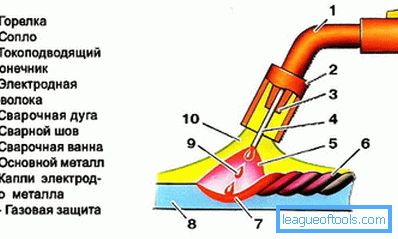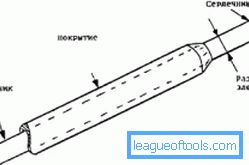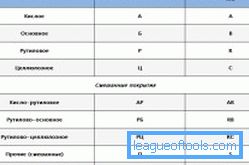How to cook stainless steel electrode
High-quality welding of stainless steel in a domestic environment is not an easy task. To know how to cook stainless steel electrode, you must have an idea of the properties inherent in high-alloyed metal grades. Stainless steel belongs to this category. the role of the main alloying element is played by chromium, the content of which reaches 20%. In addition to chromium, molybdenum, titanium, and also manganese and a number of other chemical elements can be in this type of steel.

The scheme of welding stainless steel.
What influences the welding of stainless steel elements?
If you are going to weld stainless steel with an electrode, then you need to take into account a number of material properties that will directly affect the welding process:
- Nonlinear expansion coefficient. It is somewhat larger than other metals. Therefore, observe a slightly larger clearance during welding, especially if you have to work with thicker parts, otherwise deformations are not excluded.
- Thermal conductivity. It is about 2 times lower than that of low-alloy steel. Because of this, parts are welded at a current strength that is 20% lower than with ordinary steel.
- Loss of anti-corrosion properties (or intercrystalline corrosion). During the welding of metal grains, iron and chromium carbide begins to form, due to which the metal is subjected to corrosion. In order to prevent such a phenomenon, the welding zone is usually promptly cooled.
Electrode selection

Diagram of the device electrode.
The choice of the most suitable electrode is associated with the grade of stainless steel, its composition. Therefore, for today, electrodes for stainless steel are classified depending on what you have to weld:
- stainless steel used in the food industry: OZL-8, CL-11;
- steel with increased resistance to corrosion: НЖ-13, ЭА-400 / 10У, less often ЦТ-15;
- heat-resistant alloys, which include stainless steel: OZL-6;
- stainless steel used for the manufacture of tools: TsT-28, KTI-7A;
- heterogeneous alloys: ANZHR-1 and 2, EA-395/9.
Electrodes specially designed for welding stainless steels are easy to use, but also dangerous at the same time. When the finished weld is cooled, slags that are heated to a high temperature rebound: on the one hand this is convenient, since no metal cleaning is required, but on the other hand, there is a risk of burn. Therefore, when cooling the weld zone, simply stand aside. It is safest to perform welding at the lower position of the seam, however, if it became necessary to change the position, then it is necessary to use electrodes TsL-11, which allow to perform work in all positions. The most common today are 3 brands of electrodes, the features of which are worth considering in more detail.
Back to table of contentsWelding electrodes TsL-11

Table of the types of electrodes.
These products are used in the welding of chromium-nickel steels 12X18H9T and 10T, as well as 08X18H12B and T (in last letters). Those. The use of CL-11 is advisable when special requirements for intergranular corrosion are imposed on the parts to be welded. These electrodes show themselves well at a temperature not higher than + 450 ° C, since covered with the composition, which includes fluorine compounds and carbonates. The main advantages of TsL-11 are weak spattering of metal droplets, good toughness, acceptable ductility, and the absence of the possibility of cracking - a consistently smooth seam is obtained.
Back to table of contentsWelding with the use of NZh-13 and OZL-6
The first type of electrodes is best used when welding elements made from food grade stainless steel or parts made from nickel-chromium nickel-molybdenum alloys. OZL-6 shows the best results when working in an oxidizing environment and under high heating (up to 1000 ° С). The seam will turn out qualitative if to use a direct current. The advantages of OZL-6 include heat resistance, minimal splashing of metal droplets, resistance to intercrystalline corrosion. It is not allowed to cook the stainless steel electrode OZL-6 in a vertical position.
Back to table of contents
Features of welding stainless steel parts
In domestic conditions, cooking stainless steel with an electrode is best with an inverter welding machine, which will make it possible to join parts with a thickness of up to 1.5 mm. Depending on the thickness of the parts to be joined, it is necessary to select the appropriate power of the inverter. It is desirable that he had the function of "anti-sticking" (Anti Stick), in order to prevent blinking of light bulbs and the failure of household appliances. All work is desirable to perform at a temperature not lower than minus 10 ° C.
It is worth noting in advance that welding with the use of coated electrodes is used when there are no special quality requirements for the welded joint.
Before work, clean the edges of the parts with a metal brush and treat with nitrosolvent. This will prevent the appearance of pores in the seam and make the arc more stable. Welding is performed by means of a current having reverse polarity. In the process, try to use electrodes of the smallest diameter so as not to melt the seam. At the same time, keep in mind that when welding a stainless steel, the electrodes melt faster. To ensure the fastest possible cooling, use gaskets made of brass, copper.
During welding, keep in mind that raising the temperature to + 500 ° C will cause the occurrence of crystal-like cracks, which will weaken the structure: its plastic properties will decrease, it will become brittle. Plus, use the following guidelines:
- minimize the gap between tacks;
- Before starting welding, heat the part up to 1000 ° С, then gradually cool it in air for 3 hours;
- Cook as fast as possible so as not to expose the structure to prolonged heat. It is better to do several alternating passes, using cooling to + 100 ° C.
After completion of the work, the seam must be subjected to certain processing, since A thin chrome layer is formed on it, which must be removed to ensure good strength and prevent corrosion. To remove chromium, it is possible to process parts with a high (1000-1200 ° C) temperature, etch with phosphoric, nitric acid: such an operation will additionally increase the strength of the seam. In some cases, the finished product is machined with grinding tools.